 W
WAn ocean is a body of water that composes much of a planet's hydrosphere. On Earth, an ocean is one of the major conventional divisions of the World Ocean. These are, in descending order by area, the Pacific, Atlantic, Indian, Southern (Antarctic), and Arctic Oceans. The phrases "the ocean" or "the sea" used without specification refer to the interconnected body of salt water covering the majority of the Earth's surface. As a general term, "the ocean" is mostly interchangeable with "the sea" in American English, but not in British English. Strictly speaking, a sea is a body of water partly or fully enclosed by land.
 W
WThe sea, the world ocean, or simply the ocean is the connected body of salty water that covers about 71% of Earth's surface, with a total volume of roughly 1,332,000,000 cubic kilometres [320,000,000 cu mi]. It moderates Earth's climate and has important roles in the water cycle, carbon cycle, and nitrogen cycle. It has been travelled and explored since ancient times, while the scientific study of the sea—oceanography—dates broadly from the voyages of Captain James Cook to explore the Pacific Ocean between 1768 and 1779. The word sea is also used to denote smaller, partly landlocked sections of the ocean and certain large, entirely landlocked, saltwater lakes, such as the Caspian Sea and the Dead Sea.
 W
WThe Arctic Ocean is the smallest and shallowest of the world's five major oceans. It is also known as the coldest of all the oceans. The International Hydrographic Organization (IHO) recognizes it as an ocean, although some oceanographers call it the Arctic Mediterranean Sea. It is sometimes classified as an estuary of the Atlantic Ocean, and it is also seen as the northernmost part of the all-encompassing World Ocean.
 W
WThe Atlantic Ocean is the second-largest of the world's oceans, with an area of about 106,460,000 km2 (41,100,000 sq mi). It covers approximately 20 percent of Earth's surface and about 29 percent of its water surface area. It is known to separate the "Old World" from the "New World" in European perception of the World.
 W
WBeach nourishment describes a process by which sediment, usually sand, lost through longshore drift or erosion is replaced from other sources. A wider beach can reduce storm damage to coastal structures by dissipating energy across the surf zone, protecting upland structures and infrastructure from storm surges, tsunamis and unusually high tides. Beach nourishment is typically part of a larger Integrated coastal zone management aimed at coastal defense. Nourishment is typically a repetitive process since it does not remove the physical forces that cause erosion but simply mitigates their effects.
 W
WThe borders of the oceans are the limits of Earth's oceanic waters. The definition and number of oceans can vary depending on the adopted criteria.
 W
WThe Central Indo-Pacific is a biogeographic region of Earth's seas, comprising the tropical waters of the western Pacific Ocean, the eastern Indian Ocean, and the connecting seas.
 W
WOcean colonization or ocean colonisation, is the theory of developing artificial structures, both floating on the ocean surface and submerged below, to extend the permanent living space available to society
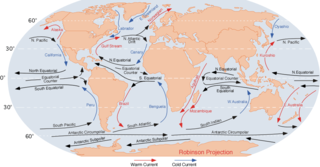 W
WAn ocean current is a continuous, directed movement of sea water generated by a number of forces acting upon the water, including wind, the Coriolis effect, breaking waves, cabbeling, and temperature and salinity differences. Depth contours, shoreline configurations, and interactions with other currents influence a current's direction and strength. Ocean currents are primarily horizontal water movements.
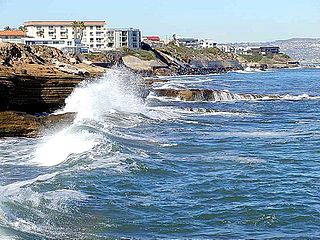 W
WEffects of climate change on oceans provides information on the various effects that global warming has on oceans. Global warming can affect sea levels, coastlines, ocean acidification, ocean currents, seawater, sea surface temperatures, tides, the sea floor, weather, and trigger several changes in ocean bio-geochemistry; all of these affect the functioning of a society.
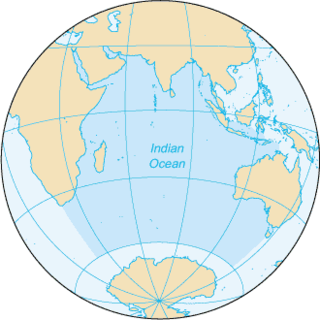 W
WThe Indian Ocean is the third-largest of the world's oceanic divisions, covering 70,560,000 km2 (27,240,000 sq mi) or 19.8% of the water on Earth's surface. It is bounded by Asia to the north, Africa to the west and Australia to the east. To the south it is bounded by the Southern Ocean or Antarctica, depending on the definition in use. Along its core, the Indian Ocean has some large marginal or regional seas such as the Arabian Sea, the Laccadive Sea, the Somali Sea, Bay of Bengal, and the Andaman Sea.
 W
WThe Indo-Pacific, sometimes known as the Indo - West Pacific or Indo-Pacific Asia, is a biogeographic region of Earth's seas, comprising the tropical waters of the Indian Ocean, the western and central Pacific Ocean, and the seas connecting the two in the general area of Indonesia. It does not include the temperate and polar regions of the Indian and Pacific oceans, nor the Tropical Eastern Pacific, along the Pacific coast of the Americas, which is also a distinct marine realm.
 W
WThe land and water hemispheres of Earth, sometimes capitalised as the Land Hemisphere and Water Hemisphere, are the hemispheres of Earth containing the largest possible total areas of land and ocean, respectively. By definition, the two hemispheres do not overlap.
 W
WThis is a list of bodies of water by salinity that is limited to natural bodies of water that have a stable salinity above 0.05%, at or below which water is considered fresh.
 W
WThe Ocean Explorers Grand Slam is an adventurer goal to complete open-water crossings on all five oceans using human-powered vessel.
 W
WAn ocean world, ocean planet, water world, aquaplanet or panthalassic planet is a type of terrestrial planet that contains a substantial amount of water either at its surface or within a subsurface ocean. The term ocean world is also used sometimes for astronomical bodies with an ocean composed of a different fluid or thalassogen, such as lava, ammonia or hydrocarbons like on Titan's surface.
 W
WOceans is a 2009 French nature documentary film directed, produced, co-written, and narrated by Jacques Perrin, with Jacques Cluzaud as co-director. The film, produced in association with the Census of Marine Life, explores the marine species of Earth's five oceans and reflects on the negative aspects of human activity on the environment, with Perrin providing narration.
 W
WThe Pacific Ocean is the largest and deepest of Earth's oceanic divisions. It extends from the Arctic Ocean in the north to the Southern Ocean in the south and is bounded by the continents of Asia and Australia in the west and the Americas in the east.
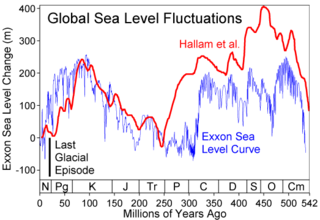 W
WGlobal or eustatic sea level has fluctuated significantly over Earth's history. The main factors affecting sea level are the amount and volume of available water and the shape and volume of the ocean basins. The primary influences on water volume are the temperature of the seawater, which affects density, and the amounts of water retained in other reservoirs like rivers, aquifers, lakes, glaciers, polar ice caps and sea ice. Over geological timescales, changes in the shape of the oceanic basins and in land/sea distribution affect sea level. In addition to eustatic changes, local changes in sea level are caused by tectonic uplift and subsidence.
 W
WThe "Seven Seas" is an ancient phrase for all of the world's oceans. Since the 19th century, the term has been taken to include seven oceanic bodies of water:the Arctic Ocean the North Atlantic Ocean the South Atlantic Ocean the Indian Ocean the North Pacific Ocean the South Pacific Ocean the Southern Ocean
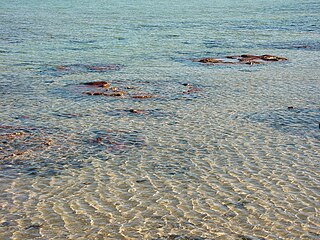 W
WShallow water marine environment refers to the area between the shore and deeper water, such as a reef wall or a shelf break. This environment is characterized by oceanic, geological and biological conditions, as described below. The water in this environment is shallow and clear, allowing the formation of different sedimentary structures, carbonate rocks, coral reefs, and allowing certain organisms to survive and become fossils.
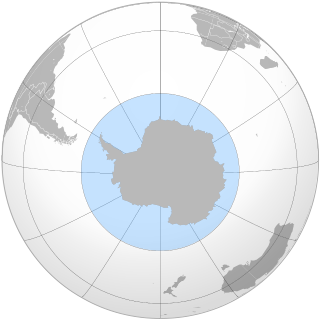 W
WThe Southern Ocean, also known as the Antarctic Ocean or the Austral Ocean, comprises the southernmost waters of the World Ocean, generally taken to be south of 60° S latitude and encircling Antarctica. As such, it is regarded as the second-smallest of the five principal oceanic divisions: smaller than the Pacific, Atlantic, and Indian Oceans but larger than the Arctic Ocean.
 W
WThe Western Indo-Pacific is a biogeographic region of the Earth's seas, comprising the tropical waters of the eastern and central Indian Ocean. It is part of the larger Indo-Pacific, which includes the tropical Indian Ocean, the western and central Pacific Ocean, and the seas connecting the two in the general area of Indonesia. The Western Indo-Pacific may be classified as a marine realm, one of the great biogeographic divisions of the world's ocean basins, or as a subrealm of the Indo-Pacific.
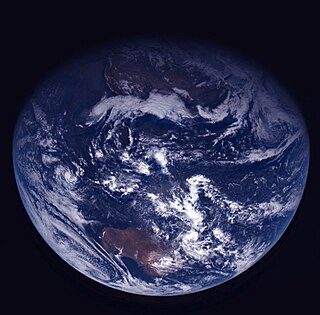 W
WThe World Ocean or Global Ocean is the interconnected system of Earth's oceanic waters, and comprises the bulk of the hydrosphere, covering 361,132,000 square kilometres or 139,434,000 square miles (70.8%) of Earth's surface, with a total volume of roughly 1,332,000,000 cubic kilometres.
 W
WWorld Oceans Day is an international day that takes place annually on 8 June. The concept was originally proposed in 1992 by Canada's International Centre for Ocean Development (ICOD) and the Ocean Institute of Canada (OIC) at the Earth Summit – UN Conference on Environment and Development (UNCED) in Rio de Janeiro, Brazil. World Oceans Day was officially recognised by the United Nations in 2008. The international day supports the implementation of worldwide Sustainable Development Goals (SDGs) and fosters public interest in the management of the ocean and its resources.